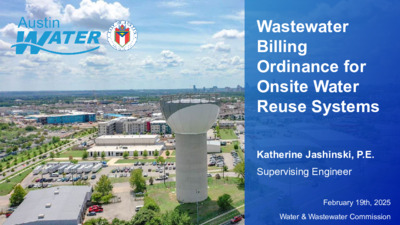Item 4 - Wastewater Billing Briefing Slides — original pdf
Backup

Wastewater Billing Ordinance for Onsite Water Reuse Systems Katherine Jashinski, P.E. Supervising Engineer February 19th, 2025 Water & Wastewater Commission Agenda Intro to GoPurple and Onsite Water Reuse Options for Billing for Wastewater Wastewater Flow Factor Billing Proposed Ordinance Q&A 2 Intro to GoPurple and Onsite Water Reuse GoPurple Austin City Council Adoption on March 7th 2024 Code Changes for Onsite Water Reuse and Reclaimed Water Connections Affordability Strategies for Reuse Projects New community Benefit Charge increase ($0.15 per thousand gallons) to fund Reclaimed Water System expansion and Onsite Reuse programs Go Purple | AustinTexas.gov 4 Requirements for Onsite Water Reuse Systems Project Size Other Project Characteristics Required Sources 250,000 sf or greater of GFA Project has one or more commercial, multifamily or mixed use buildings Combined AC condensate and Rainwater Exception: project has four or more multifamily buildings with a FAR <1 Combined AC condensate and Rainwater Required End Uses Irrigation Toilet/urinal Cooling Tower Irrigation AC condensate Cooling Tower Less than 250,000 sf of GFA Project has a cooling tower of 100 tons or greater capacity GFA = Gross Floor Area FAR = Floor to Area Ration 5 Accounting for Wastewater Contributions from Onsite Water Reuse Systems 6 Austin Central Library: Lessons Learned 7 Considerations for Private Meters for Wastewater Billing 8 Cost to add additional metering reduces the affordability of the systems Location of private meters within buildings requires self-reporting Maintenance and calibration of meters increases workload for facility managers Manual Billing to get meter reads into Austin's billing system adds substantial workload and increases staffing needs at AW Options for Billing for Wastewater 1. Wastewater averaging 2. Gallon for gallon 3. Wastewater billing adjustments for evaporative cooling towers 4. Metered wastewater billing City Code Chapter 15-9 (Utility Regulations) City Code Specifies Current Options for Wastewater Billing 10 Metering and Billing for Existing Customers Residential Commercial ~ 95% of AW customers ~5% of AW customers Wastewater Averaging Water = Domestic meter consumption WW = Average meter consumption Nov-March Gallon for Gallon Water = Domestic + Irrigation meter consumption WW = Domestic meter consumption 11 Evaporative Loss Adjustment Program for Cooling Towers Private meter IN Approximately 120 AW customers participate These customers: • reapply every 5 years • are responsible for the ownership and maintenance of their private meters which support the cooling tower system • self report their reads through an online portal • the readings must occur on the same day as the City’s meter is read • Once the reads are validated, AW staff provide credits to the customer bill for the true flows to the wastewater system Blowdown Private meter BD Evaporative Loss Water = Domestic meter consumption WW = Domestic meter consumption + (BD - IN) 12 Billing for Wastewater Only by Flow Meters 20 Customers The customers: • Install WW flow meters and a remote terminal unit to collect and transmit data to AW • Are responsible for the ownership and maintenance of the RTU data logger RTU and meters billing system • Email the flow meter data to AW which is input into the WW Private meter WW Flow Monitoring Water = Domestic meter consumption WW = WW billing meter 13 Wastewater Flow Factor Billing Wastewater Flow Factor Billing Use Engineering Calculations for Wastewater Flow 15 OWRS projects require the customer to complete a detailed water balance calculator to accurately assess water used and wastewater generated for their buildings San Antonio Water System (SAWS) has a similar program allowing for engineered calculations for wastewater billing for commercial customers with consumptive uses San Francisco Public Utilities was going to use this method for their onsite water reuse program, but their billing system couldn’t accommodate it Example Wastewater Flow Factor Calculation Potable Fixtures = 1/4 Indoor Water Use Non-potable Fixtures = 3/4 Indoor Water Use WWFF = (1/4 + 3/4) / 1/4 = 4 Billing Consumption Water = D + NP WW = 4D 16 Converting Evaporative Loss Customers to WW Flow Factor Billing WWFF = D - IN + BD D Use 5 years of evaporative loss data to establish WW Flow Factor D IR D IR 17 Meter W billing volume WW billing volume WWFF x D Proposed Ordinance City Code Chapter 15-9 (Utility Regulations) Proposing to Amend City Code to Add Wastewater Flow Factor Billing for Customers with Onsite Water Reuse Systems 1. Wastewater averaging 2. Gallon for gallon Qualified evaporative loss customers can apply for wastewater flow factor billing during 5-year renewal 3. Wastewater billing adjustments for evaporative cooling towers 4. Metered wastewater billing 5. Wastewater flow factor billing for onsite water reuse systems 19 Reduces number of meters and costs required for projects Reduces manual tracking and submission of meter reads No impact to budget or housing affordability (neutral AIS) Billing method used by peer utility (SAWS) Summary Proposed ordinance allows for more efficient WW billing for buildings with OWRS and evaporative cooling towers 20 Questions?